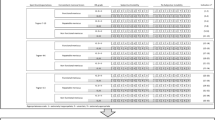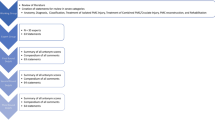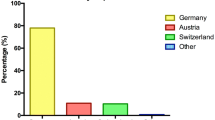Abstract
Purpose
To describe preferences and to quantify the amount of agreement among orthopaedic surgeons regarding treatment options for four clinical scenarios of knee pathologies.
Methods
A web-based survey was developed to investigate the attitudes of members of an international association of surgeons specialised in sports traumatology and knee surgery European Society of Sports Traumatology, Knee Surgery and Arthroscopy.
Results
The response rate was 40 % (412 questionnaires). An inter-rater agreement score (the Normalised Chi-square based Agreement Nomogram, NX2A) was calculated for each question. For scenario 1, 56-year-old male, degenerative medial compartment on both the femoral and tibial side, the surgical approach was preferred to the conservative approach (p < 0.001). Biological procedures were not considered appropriate, and in this respect, the respondents achieved a moderate degree of agreement (NX2A = 0.68). For scenario 2, 35-year-old male, early knee medial arthritis, the surgical treatment was preferred to conservative treatment (p < 0.001). The traditional closed-wedge tibial osteotomy was not regarded as an appropriate treatment with an excellent degree of agreement among surgeons (NX2A = 0.76). For scenario 3, 46-year-old male, ACL lesion, there was an almost disagreement, as respondents showed no preference between a surgical and conservative approach (NX2A = 0.005). Among surgical treatments, an almost perfect agreement with regard to the appropriateness of arthroscopic single-bundle ACL reconstruction with a semitendinosus/gracilis graft was reached by the surgeons (NX2A = 0.8). For scenario 4, 69-year-old male, diffuse knee arthritis (all the compartments), an almost perfect agreement in favour of a total knee prosthesis was obtained for the management of this scenario (NX2A = 0.85).
Conclusions
Web-based survey can help orthopaedic surgeons discuss and propose indications for clinical practice in the management of some of the most common joint diseases.
Level of evidence
Cross-sectional survey, Level V.

Similar content being viewed by others
References
Banerjee M, Capozzoli M, McSweeney L, Sinha D (1999) Beyond kappa: a review of interrater agreement measures. Can J Stat 27(1):3–23
Bannuru RR, Natov NS, Obadan IE, Price LL, Schmid CH, McAlindon TE (2009) Therapeutic trajectory of hyaluronic acid versus corticosteroids in the treatment of knee osteoarthritis: a systematic review and meta-analysis. Arthritis Rheum 61(12):1704–1711
Bellamy N, Campbell J, Robinson V, Gee T, Bourne R, Wells G (2006) Intraarticular corticosteroid for treatment of osteoarthritis of the knee. Cochrane Database Syst Rev (2):CD005328
Bennell K, Hinman R (2005) Exercise as a treatment for osteoarthritis. Curr Opin Rheumatol 17(5):634–640
Beynnon BD, Johnson RJ, Abate JA, Fleming BC, Nichols CE (2005) Treatment of anterior cruciate ligament injuries, part 2. Am J Sports Med 33(11):1751–1767
Beynnon BD, Johnson RJ, Abate JA, Fleming BC, Nichols CE (2005) Treatment of anterior cruciate ligament injuries, part I. Am J Sports Med 33(10):1579–1602
Biau DJ, Tournoux C, Katsahian S, Schranz PJ, Nizard RS (2006) Bone-patellar tendon-bone autografts versus hamstring autografts for reconstruction of anterior cruciate ligament: meta-analysis. BMJ 332(7548):995–1001
Cabitza F (2012) Harvesting collective agreement in community oriented surveys: the medical case. In: Dugdale J, Masclet C, Grasso MA, Boujut JF, Hassanaly P (eds) From research to practice in the design of cooperative systems: results and open challenges. Springer, London
Eysenbach G, Wyatt J (2002) Using the internet for surveys and health research. J Med Internet Res 4(2):E13
Feinstein AR, Cicchetti DV (1990) High agreement but low kappa: I. The problems of two paradoxes. J Clin Epidemiol 43(6):543–549
Foster TE, Wolfe BL, Ryan S, Silvestri L, Kaye EK (2010) Does the graft source really matter in the outcome of patients undergoing anterior cruciate ligament reconstruction? An evaluation of autograft versus allograft reconstruction results: a systematic review. Am J Sports Med 38(1):189–199
Gandhi R, Tsvetkov D, Davey JR, Mahomed NN (2009) Survival and clinical function of cemented and uncemented prostheses in total knee replacement: a meta-analysis. J Bone Joint Surg Br 91(7):889–895
Gwet K (2001) Handbook of inter-rater reliability. STATAXIS Publishing Company, Gaithersburg
Hunt RJ (1986) Percent agreement, Pearson’s correlation, and kappa as measures of inter-examiner reliability. J Dent Res 65(2):128–130
Jacobs WC, Clement DJ, Wymenga AB (2005) Retention versus sacrifice of the posterior cruciate ligament in total knee replacement for treatment of osteoarthritis and rheumatoid arthritis. Cochrane Database Syst Rev (4):CD004803
Kellerman SE, Herold J (2001) Physician response to surveys. A review of the literature. Am J Prev Med 20(1):61–67
Krippendorff K (2004) Content analysis: an introduction to its methodology. Sage Publications Inc., Thousand Oaks
Lee JY, Hohl JB, Fedorka CJ, Devin C, Brodke DS, Branch CL Jr, Vaccaro AR (2011) Surgeons agree to disagree on surgical options for degenerative conditions of the cervical and lumbar spine. Spine (Phila Pa 1976) 36(3):E203–E212
Linko E, Harilainen A, Malmivaara A, Seitsalo S (2005) Surgical versus conservative interventions for anterior cruciate ligament ruptures in adults. Cochrane Database Syst Rev (2):CD001356
Luites JW, Brinkman JM, Wymenga AB, van Heerwaarden RJ (2009) Fixation stability of opening-versus closing-wedge high tibial osteotomy: a randomised clinical trial using radiostereometry. J Bone Joint Surg Br 91(11):1459–1465
Marx RG, Jones EC, Angel M, Wickiewicz TL, Warren RF (2003) Beliefs and attitudes of members of the American Academy of Orthopaedic Surgeons regarding the treatment of anterior cruciate ligament injury. Arthroscopy 19(7):762–770
Meredick RB, Vance KJ, Appleby D, Lubowitz JH (2008) Outcome of single-bundle versus double-bundle reconstruction of the anterior cruciate ligament: a meta-analysis. Am J Sports Med 36(7):1414–1421
Mohtadi NG, Chan DS, Dainty KN, Whelan DB (2011) Patellar tendon versus hamstring tendon autograft for anterior cruciate ligament rupture in adults. Cochrane Database Syst Rev 9:CD005960
Mosca L, Linfante AH, Benjamin EJ, Berra K, Hayes SN, Walsh BW, Fabunmi RP, Kwan J, Mills T, Simpson SL (2005) National study of physician awareness and adherence to cardiovascular disease prevention guidelines. Circulation 111(4):499–510
Obremskey WT, Pappas N, Attallah-Wasif E, Tornetta P 3rd, Bhandari M (2005) Level of evidence in orthopaedic journals. J Bone Joint Surg Am 87(12):2632–2638
Randelli P, Arrigoni P, Cabitza F, Ragone V, Cabitza P (2011) Current practice in shoulder pathology: results of a web-based survey among a community of 1,084 orthopedic surgeons. Knee Surg Sports Traumatol Arthrosc. doi:10.1007/s00167-011-1673-z
Ronn K, Reischl N, Gautier E, Jacobi M (2011) Current surgical treatment of knee osteoarthritis. Arthritis 2011:454873
Song EK, Seon JK, Park SJ, Jeong MS (2010) The complications of high tibial osteotomy: closing-versus opening-wedge methods. J Bone Joint Surg Br 92(9):1245–1252
Vasiliadis HS, Wasiak J (2010) Autologous chondrocyte implantation for full thickness articular cartilage defects of the knee. Cochrane Database Syst Rev (10):CD003323
Warrens MJ (2010) Inequalities between multi-rater kappas. Adv Data Anal Classif 4:271–286
Wasiak J, Clar C, Villanueva E (2006) Autologous cartilage implantation for full thickness articular cartilage defects of the knee. Cochrane Database Syst Rev (3):CD003323
Webster BS, Courtney TK, Huang YH, Matz S, Christiani DC (2005) Physicians’ initial management of acute low back pain versus evidence-based guidelines. Influence of sciatica. J Gen Intern Med 20(12):1132–1135
Author information
Authors and Affiliations
Corresponding author
Rights and permissions
About this article
Cite this article
Cabitza, F., Ragone, V., Arrigoni, P. et al. Management of knee injuries: consensus-based indications from a large community of orthopaedic surgeons. Knee Surg Sports Traumatol Arthrosc 21, 708–719 (2013). https://doi.org/10.1007/s00167-012-2035-1
Received:
Accepted:
Published:
Issue Date:
DOI: https://doi.org/10.1007/s00167-012-2035-1




